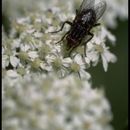Biology
provided by Arkive
House flies contaminate food, and in developing countries are responsible for millions of infant deaths per year as a result of dehydration caused by diarrhoea (5).
House flies undergo 'complete metamorphosis'; the larvae (maggots) progress through three stages known as 'instars' before a pupal stage develops in which complex changes take place as the body of the maggot re-organises into the adult fly (4). Adults feed on rotting plant and animal matter and sugary liquids. They repeatedly salivate on food, ingest it and regurgitate it in order to pre-digest the food (4).
Conservation
provided by Arkive
Not relevant.
Description
provided by Arkive
The house fly is, perhaps, the most common and widespread animal in the world (3). It is a serious pest, which spreads many disease-causing pathogens including Salmonella, anthrax and polio (4). It is greyish in colour with four dark stripes along the back (4). Like all flies it has one pair of membranous 'true' wings; the second pair of wings are modified into drumstick-like appendages known as 'halteres', which are used in balance. The sponge-like mouthparts are adapted for feeding on liquids, and the reddish compound eyes are large (5).
Habitat
provided by Arkive
Occurs in a wide range of habitats, and is often associated with human activities (1); tends to breed in manure and decomposing material (3).
Range
provided by Arkive
This species is ubiquitous throughout Britain and is found in many parts of the world (3).
Status
provided by Arkive
Very common and widespread (1).
Threats
provided by Arkive
This species is not threatened. It is subject to control measures in some areas as it can be a serious pest (6).

